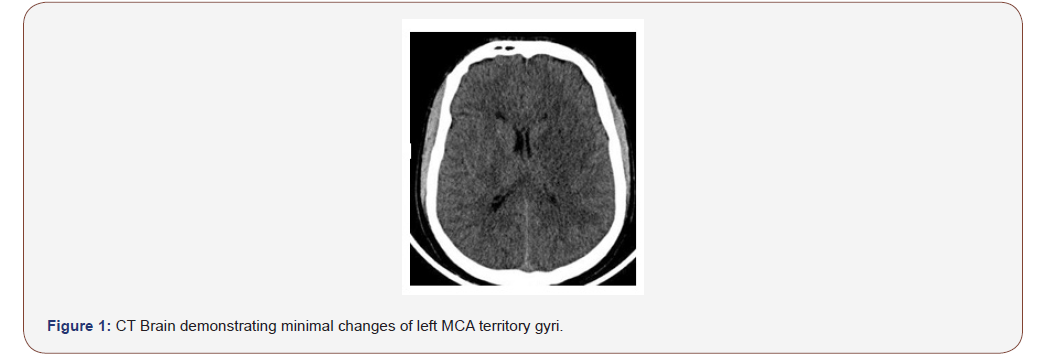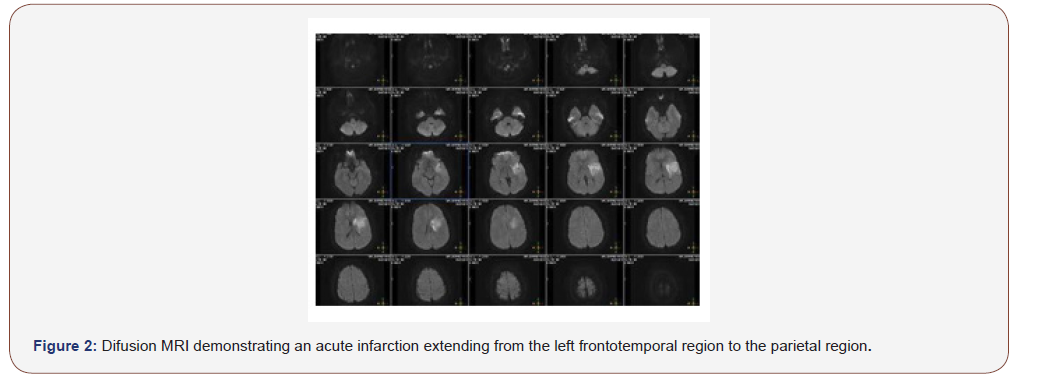 Case Report
Case Report
Stroke as a Very Rare Complication of Multile Bee Sting: A Case Report
GUNTEL Murat1*, CAN Hakan1, SELCUK Dilan1 and DEMETGUL Özcan2
1Department of Neurology, Hatay Mustafa Kemal University, Turkey
2Neurology Clinic, Hatay State Hospital, Turkey
GUNTEL Murat, Department of Neurology, Hatay Mustafa Kemal University, Turkey.
Received Date: February 18, 2020; Published Date: February 26, 2020
Abstract
Bee stings are observed quite frequently all over the world [1]. A wide variety of symptoms and clinical manifestations can occur after a bee sting. Local reactions at the bite site are common and self-limiting. Pain, itching, urticaria, swelling, edema and redness are common local reactions. Uncommonly manifestations like tongue, soft palate and eyelid swelling, cough, dyspnea, nausea, vomiting, stomachache, diarrhea, generalized edema, anaphylactic shock, hypotension, multiple organ failure, vasculitis, serum sickness, neuritis and meningoensefalitis may occur [2]. We report a case of a 27-year-old male who developed right sided hemiparesia and disphasia following multiple bee stings.
Keywords: Bee stings; Stroke; Hemiparesia
Introduction
Anaphylactic shock and systemic allergic reactions can be said as the reason for hospitalization after bee stings. Vascular events due to bee stings are extremely rare and, in the literature, stroke cases due to bee sting are very few [3]. We wanted to report a patient who had a stroke due to multiple bee stings.
Case Report
A 27-year-old male patient was brought to the emergency service due to multiple bee stings. He had been stung multiple times from his right hand (2 times), right leg (2 times) and his face. In the emergency service, 30 minutes later after the stung, he had been given ıntravenous antihistamines and corticosteroid and he was discharged out from the hospital. Approximately 18 hours later, in the morning of the other day, he woke up and found that he has right upper and lower extremite weakness. He could not speak, he could express himself with signs. Then he was brought to the hospital. On general examination, he had normal blood pressure, normal pulse and normal respiratory values. He had a large number of erythematous rashes on his leg, hand and face. Neurological examination revealed the patient had dysphasia and right sided hemiparesia. His right upper extremite motor power was 1-2/5, lower extremite was 3-4/5. There was no important feature in the patient’s CV. Fundus examination was normal.
Computed tomography (CT) of the brain performed as soon as he was admitted to the hospital. CT revaled minimal changes of left MCA territory gyri (Figure 1).
Then difusion magnetic resonance imaging (MRI) performed to the patient immediately, On the diffusion MRI, an acute infarction was detected extending from the left frontotemporal region to the parietal region (Figure 2).
ECG and echocardiography were normal. His hemogram, liver and kidney function tests, bleeding and clotting time and IgE level were normal. D-dimer analysis and all thrombophilia panel was detected as normal.


We transfer the patient to the intensive care unit and started medical treatment immediately. Patient was treated aspirin, heparin and antiodema drugs. On the 3rd day of hospitalization, his right sided hemiparesia improved partially. His speech improved almost completely. On the outpatient clinic, the patient was followed 3 days, his right sided limb weakness (he had 4/5 power on his affected side) and speech improved before his discharge from the hospital.
Discussion
Pain, swelling and redness may be observed as local reactions after bee stings [4]. When we review the literature, the case of stroke due to bee stings is very few. Neurologic reactions, including stroke after bee stings, are very rare [5]. The pathophysiology of stroke due to bee sting is still uncertain. The underlying mechanism can be said as follows: 1) Hypotension caused by anaphylaxis or due to histamine release may induce cerebral ischaemia. 2) Mediators released after bee sting cause vasoconstriction. Exogenous adrenaline also exacerbates this situation. Platelet aggregation also contributes to hypertension and cerebral ischemia. 3) Bee venom itself contains vasoactive and inflammatory mediators (histamine, thromboxane, leucotrienes, dopamin, noradrenaline and other). These mediators also cause cerebral ischemia. Both thromboxane and leukotrienes have been shown to cause vasoconstriction resulting in cerebral infarction [6]. Both cerebral hemorrhage and cerebral infarction can be observed after bee stings. In our case, we thougt that acute ischemic stroke due to the bee sting caused by vasoconstriction and the prothrombotic state.
Conclusion
As a result, neurological events associated with bee stings such as stroke are very rare and have no proven pathophysiological mechanisms. we presented this case because of its rarity.
Acknowledgement
None.
Conflict of Interest
No conflict of interest.
References
- Ewan PW (1998) Venom allergy. Bmj 316(7141): 1365-1368.
- Maltzman JS, Lee AG, Miller NR (2000) Optic neuropathy occurring after bee and wasp sting. Ophthalmology 107(1): 193-195.
- Viswanathan S, Muthu V, Singh AP, Rajendran R, George R (2012) Middle cerebral artery infarct following multiple bee stings. J Stroke Cerebrovasc Dis 21(2): 148-150.
- Heinig JH, Engel T, Weeke ER (1988) Allergy to venom from bee or wasp: the relation between clinical and immunological reactions to insect stings. Clin Allergy 18(1): 71-78.
- Rajendiran C, Puvanalingam A, Thangam D, Ragunanthanan S, Ramesh D, et al. (2012) Stroke after multiple bee sting. J Assoc Physicians India 60: 122-124.
- Crawley F, Schon F, Brown MM (1999) Cerebral infarction: a rare complication of wasp sting. J Neurol Neurosurg Psychiatry 66(4): 550-551.
-
GUNTEL M, CAN H, SELCUK D, DEMETGUL Ö. Stroke as a Very Rare Complication of Multile Bee Sting: A Case Report. Arch Neurol & Neurosci. 7(2): 2020. ANN.MS.ID.000659.
-
Neurology, Bee stings, Stroke, Hemiparesia, Vascular events, Intravenous, Brain, Neurologic reactions.
-

This work is licensed under a Creative Commons Attribution-NonCommercial 4.0 International License.






